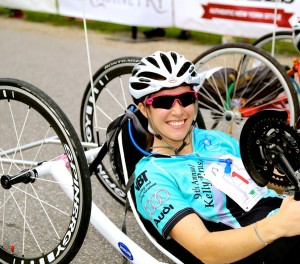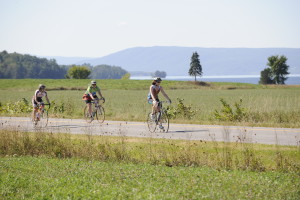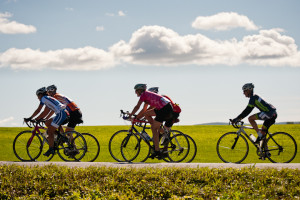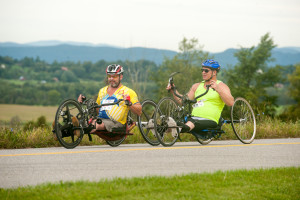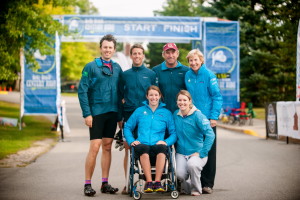Kelly Brush Davisson has a story to tell and work to do. The Kelly Brush Century Ride, September 12, 2015, will help. It is a ride to savor, remember, and feel good about. Read below what was featured in the Rutland Herald & Times Argus ACTIVE VERMONT section on 8-23-2015.
Active Vermont: ‘Getting people back to life’
As the story goes, Forest Carey, head alpine ski coach at Middlebury College in 2006, sent his athletes home for the summer with the mandate to each to “Raise $1,000 or don’t come back.”
Though there may not have been teeth in this charge, the 20 or so member team one-upped their coach by raising $60,000 for their injured teammate, Kelly Brush, to purchase adaptive equipment that would allow her to pursue her athletic dreams.
Today, Kelly Brush Davisson is still dipping into those funds.
But there’s far more to this story. Let’s go back to the beginning.
Kelly grew up skiing in Vermont and, after graduating from the Green Mountain Valley School, went on to ski for Middlebury College. Racing in February 2006, she crashed into a lift tower, broke her back, and became yet another in the growing number of spinal cord injuries.
The damage was done at T7 (the seventh disc of the thoracic spine located in the upper back) resulting in permanent and total paralysis from that point downward.
During a long and intensive rehabilitation, Kelly thought of her then-boyfriend, Zeke Davisson, her sister, Lindsay Brush, her parents, and her friends, all of whom were still out there on the slopes skiing and subject to the same risks.
“How could this have possibly happened to me?” she thought. Furthermore, what could she do to help prevent the same thing from happening to others?
At first she wanted to form a foundation to improve ski safety. “I felt like my life as an athlete was over,” she said. “then I learned I could get back.”
Getting back, however, is expensive. “It is so unfair for people who have this injury to be faced with higher life costs and then expensive equipment to help them live a full life.”
The Kelly Brush Foundation was born with a twofold purpose: to assist groups in promoting ski safety and, perhaps more significantly, to help injured individuals to explore and pursue the active lifestyle available to them with appropriate funding for adaptive equipment.
Zeke Davisson illustrates the problem a potential adaptive athlete faces: “If you want to do something active, say walk or run, you can buy yourself a good pair of shoes for less than $100 and head out the door. But if someone like Kelly wants to begin, even entry level costs are prohibitively expensive, starting at a minimum of $2,000 for equipment.”
Each year since its inception, the foundation has raised funds that are in turn awarded to selected recipients. In 2014, the foundation awarded $240,000 in grants fulfilling only a part of the $525,000 received in grant requests, yet up 62 percent from 2013. “Grants to date are nearly (if not over) $1 million,” Zeke said. The goal is to do more.
Zeke and Kelly, married in 2012, live and work as a team. I met with them at Sea Dog Brewing Company near Brunswick, Maine, where they currently live, though the foundation is located in South Burlington.
Kelly works full time as a pediatric nurse practitioner. Zeke is executive director of the Kelly Brush Foundation. One cannot spend time with this young, athletic, attractive couple without being caught up in their vivacity, enthusiasm and passion for life and their shared goals.
The fact that Kelly is in a wheelchair becomes irrelevant. She is just like everyone else.
This young woman overcame logistics and her own nerves and with the help of a team of friends, skied Tuckerman’s this spring. This same young woman not only skis, but cycles, plays golf and tennis, and drives a car to work where she pursues her chosen profession, suffering the same anxieties and stresses as others.
Kelly’s achievements are impressive. In 2009 she was awarded the NCAA Inspiration Award and followed that by winning the women’s hand cycling division of the Boston Marathon in 2011. In 2012 she was one of 10 chosen “Athletes Who Care” by Sports Illustrated, possibly topped by snagging viewers’ attention in the Buick Human Highlight Reel broadcast during the Final Four Men’s Basketball Tournament of 2013.
This year Kelly is the featured subject of a spotlight on athletes who have overcome adversity and turned that adversity into advocacy at the A2A Alliance. Anther milestone in 2015 is the 10th anniversary of the Kelly Brush Century Ride, which this year will be held on Saturday, Sept. 12.
Kelly Bush Century Ride
At a time when fundraising events proliferate, many “whose time has come” fall by the wayside from dwindling participation, the Kelly Brush Century thrives. Each year there are more cyclists, more funds raised for the foundation, and more fun had by the growing community that embraces riders new and seasoned.
Why a century ride? The Davissons are often asked that question since skiing is Kelly’s primary sport. “It just happened,” Kelly said. That first ride just took off and has mushroomed since.
Part of the attraction is the scenic and forgiving course, some of which is often described as rolling hills. The country roads meander through a piece of Vermont’s most beautiful landscape and along Lake Champlain. With the start/finish at Middlebury College, riders choose distances from 25 to 100 miles with optional turn-backs along the way. Furthermore, the event is well organized, the course well marked and the support excellent and plentiful.
Originally twice around a 50-mile loop, the full ride now continues up to Shelburne, and back, partly along the Lake. It is truly a ride designed for each participant and can be adapted according to each one’s needs for the day.
Sharing the road with hand cyclists reminds all riders why they are here (For more information, to register or to donate, go to http://kellybrushfoundation.org). Kelly, along with most hand cyclists, rides the 25-mile segment. From Jan. 1 to 7 a.m. the day of the ride there are ups and downs of planning and stress.
“It’s a really fun event, “ Kelly said. “A lot of work goes into it to make it enjoyable, a good ride, but there is definitely a stressful component.” The day itself, however, makes it all worth it.
“A month after, giving out the grant money, makes it more than worth it,” Zeke added.
One look at a smiling Kelly on century day proves the point. But right now? “As I get closer I begin to stress about the shape I’m in,” Kelly confessed. Preparation becomes a matter of logistics and conditioning.
An active lifestyle
Kelly maintains her fitness and conditioning, her athletic edge, by training and pursuing recreational and competitive activities along with Zeke, her family and friends. “You should see our garage,” Zeke said. “Kelly’s equipment claims prime real estate.”
A hand cycle is just like a bike but with three wheels. It has arms, the same gears as a regular bike and the same tires on somewhat smaller wheels but equally susceptible to flats.
Hand cycles are built for a broad range of capabilities from recreational to racing. The entry level, recreational variety is more upright and has more padding, starting at around $2,000. Racing hand cycles can range to far higher costs much the same as a two-wheeled bike, depending on materials, components and design.
Kelly added to her stable of hand cycles a mono ski and a tennis chair (similar to an everyday chair but with wheels that have enough camber to allow the chair to spin faster).
“Tennis and skiing are some of the few conventional sports that work well with or without disability,” Zeke said. Kelly also plays golf by means of her golf cart that is a power driven wheel chair designed to enable her to stand up to swing her club and drive the ball.
An investment
The Kelly Brush Century Ride is a win-win, a sure investment despite the condition of the day’s economy. Entry fees and money raised buy more than a great day for the participant, and, might I add, some of the best swag and incentive gifts around.
“All donations go directly to our mission,” Zeke said. And that mission is more expansive every year. “Over the last 2 years we have grown a ton and have become nationally recognized,” Kelly added.
The KBF has made a strategic decision to grow and has restructured accordingly. “The demand is huge and is only getting bigger,” Kelly said.
“We can never do enough,” Zeke added. “There are 12,000 newly diagnosed spinal cord injuries documented each year. An average individual grant is $3,000. We want to allow anybody with a spinal cord injury to lead an active lifestyle.”
There are two types of individuals who submit grant applications. One is clearly the athlete, perhaps injured during his or her athletic pursuit. The other is the individual who may or may not have been previously active but suddenly sees the possibilities of adding something to his or her altered life expectations.
Adaptive sports programs that offer coaching and equipment fill an essential role in developing adaptive athletes and introducing the potential to engage in sports.
“We want to be the next step,” Zeke said. “We want to offer to that individual the ability to take ownership of an active lifestyle, and to be able to join family and friends when and where the opportunity exists.”
To offer opportunity, possibility, a level playing field, this is what drives the KBF. And this is what could drive each of us as we cycle through our ride on September 12 or ask our friends for support.
“I was so active before,” Kelly said, “now this is what I want to do.” Her message? It’s all about “getting people back to life.”

